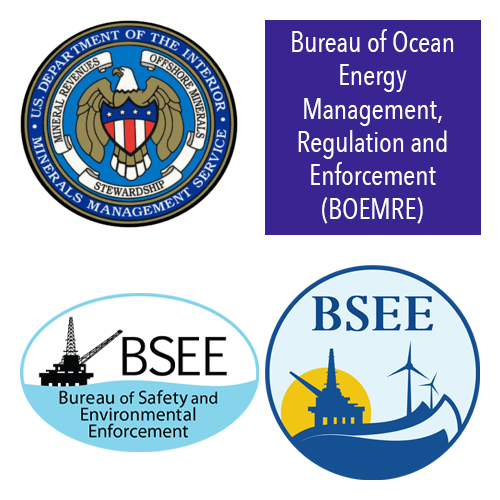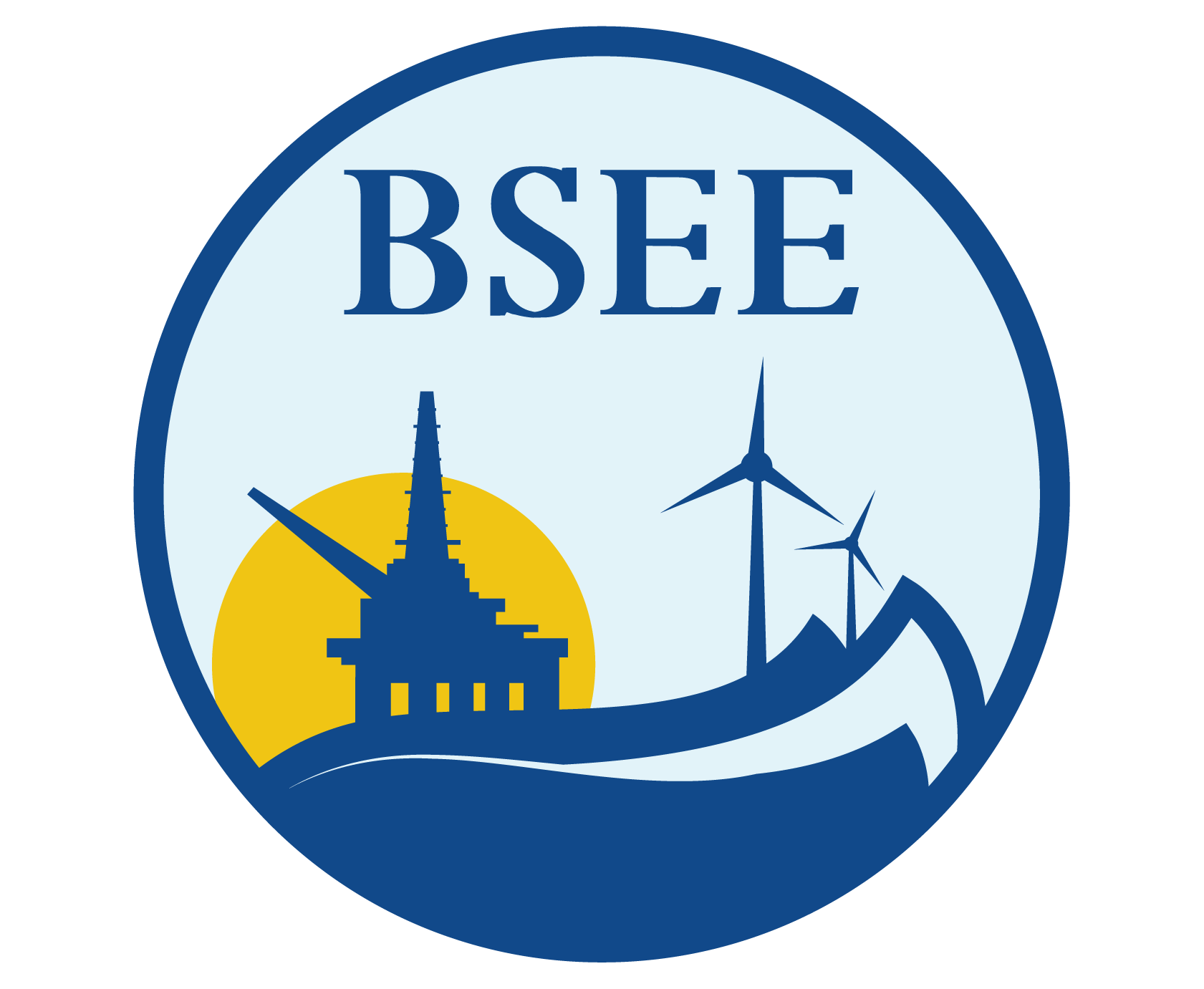Summary of BSEE History
-
1953
Passage of the Outer Continental Shelf Lands Act (OCSLA) to allow the U.S. Government to regulate the offshore energy and mineral extraction industry
-
1982
The Minerals Management Service (MMS) is created to oversee and regulated offshore energy
-
2010
The MMS is temporarily renamed to the Bureau of Ocean Energy Management, Regulation and Enforcement (BOEMRE) to more accurately describe the scope of the organization’s oversight and responsibility
-
2011
BOEMRE is split into 3 independent entities: The Bureau of Safety and Environmental Enforcement (BSEE), The Bureau of Ocean Energy Management (BOEM), and The Office of Natural Resources Revenue (ONRR)
BSEE Directors
Kevin M. Sligh Sr. (2022 to Present)
Scott Mabry (2021-2022, Acting)
Scott A. Angelle (2017-2021)
Brian Salerno (2013-2017)
James Watson (2011-2013)
Michael R. Bromwich (Oct. 1, 2011 – Nov. 30, 2011)

Regulation of the OCS
The U.S. Government began regulating the offshore energy and mineral extraction industry in the late 1940s, but its jurisdiction was not firmly established until passage of the Outer Continental Shelf Lands Act (OCSLA) of 1953. From 1953 until 2011, predecessor agencies, including the Minerals Management Service (MMS), which operated from January 19, 1982, until it was dissolved on October 1, 2011, regulated activities on the Outer Continental Shelf (OCS). After the Deepwater Horizon tragedy in April 2010, Secretary of the Interior Ken Salazar signed a Secretarial Order on May 19, 2010, dividing MMS into three independent entities to better carry out its three missions:
- Ensuring the balanced and responsible development of energy resources on the OCS;
- Ensuring safe and environmentally responsible exploration and production and enforcing applicable rules and regulations; and
- Ensuring a fair return to the taxpayer from offshore royalty and revenue collection and disbursement activities.
MMS was renamed Bureau of Ocean Energy Management, Regulation and Enforcement (BOEMRE) to more accurately describe the scope of the organization’s oversight. Michael R. Bromwich, was chosen to lead BOEMRE in June 2010, to reform the government’s regulation of offshore energy development and the agency responsible for it.
An implementation plan published by the Department of the Interior (DOI) in July 2010, called for restructuring DOI’s offshore energy management responsibilities, detailing a transition that would begin as early as October 1 and be completed in 2011.
In the place of the former MMS – and to replace BOEMRE – the federal government created three strong, independent agencies with clearly defined roles and missions. MMS – with its conflicting missions of promoting resource development, enforcing safety regulations, and maximizing revenues from offshore operations and lack of resources – could not keep pace with the challenges of overseeing industry operating in U.S. waters.
The reorganization of the former MMS was designed to remove those conflicts by clarifying and separating missions across three agencies and providing each of the new agencies with distinct missions and additional resources necessary to fulfill those missions.
Reorganization and Implementation
On October 1, 2010, U.S. government completed the first stage of the BOEMRE reorganization, creating the Office of Natural Resources Revenue (ONRR.) Residing under the jurisdiction of DOI’s Office of Policy, Management and Budget. ONRR collects, accounts for, and verifies natural resource and energy revenues due to states, American Indians, and the U.S. Treasury.
The final stage of the reorganization of BOEMRE became effective October 1, 2011, when it split into two independent entities: the Bureau of Safety and Environmental Enforcement (BSEE) and the Bureau of Ocean Energy Management (BOEM.)
BSEE was created to promote safety, protect the environment, and conserve resources offshore through vigorous regulatory oversight and enforcement. The bureau is the lead federal agency charged with improving safety and ensuring environmental protection related to the offshore energy industry, primarily oil and natural gas, and most recently renewable energy, on the U.S. OCS.
BOEM was created to manage development of OCS energy and mineral resources in an environmentally and economically responsible way. The bureau is responsible for stewardship of U.S. OCS energy and mineral resources, as well as protecting the environment that the development of those resources may impact.
Specifically, the separation of BOEM and BSEE:
- Divided resource management from safety oversight.
- Provided a structure that ensures robust environmental analyses are conducted.
- Strengthened the role of environmental review and analysis in both bureaus.
Since the first offshore well was established off the coast of California in the early twentieth century, America has seen a rapid expansion of oil and gas exploration in the marine environment. BSEE’s creation on October 1, 2011, resulted in continuous regulatory standardization and enhancement, establishing protocols to meet the nation’s energy needs while safeguarding our oceans, coastlines and the marine life making their home in and around the facilities and activities we regulate. The creation of BSEE was the most recent effort to learn from the past and establish a focused regulatory authority staffed with subject matter experts.
Reforms
The 2010 Deepwater Horizon tragedy in the Gulf of Mexico had a profound impact across the United States and led to a series of major reforms within the Department of Interior. In October of 2011 those reforms resulted in the creation of BSEE, which, from the outset, was a Bureau charged to vigorously enforce offshore safety and environmental regulations, as well as promote a culture of safety, environmental stewardship, and resource conservation. By establishing BSEE, the U.S. Government severed the safety and environmental enforcement responsibilities (which are BSEE’s jurisdiction) from revenue generation and management authority, which is vested in two separate Department of Interior agencies (Bureau of Ocean Energy Management (BOEM) and Office of Natural Resources Revenue (ONRR)).
The changes BSEE has made since 2011 involve everything from well design and workplace safety to corporate accountability. The ultimate goal of BSEE’s reforms is to help ensure that the United States can safely and responsibly develop its energy resources on the Outer Continental Shelf. Among the many operational and organizational reforms that have occurred because of the creation of BSEE, the following are among the most significant:
Reducing Risk through Enhanced Well Design and Casing Standards
The 2010 Drilling Safety Rule requires that permit applications for drilling projects meet heightened standards for well-design, casing and cementing.
Increasing Inspection and Engineering Workforce
The number of BSEE inspectors in the Gulf of Mexico OCS Region has increased from 55 in April 2010 to 92 in 2016. For the entire U.S., BSEE has 121 inspectors. BSEE inspectors now specialize in well or production operations; this specialization allows for more training and time devoted to a specific area of inspection. The engineer workforce has increased from 106 at BSEE’s inception in 2011 to 129 in 2016. This staff increase allows for more thorough review of permits, and more analysis to ensure compliance with enhanced standards.
Promoting Safety Culture and Continuous Improvement at All Levels of Industry
The 2010 Safety and Environmental Management System (SEMS) rule establishes performance based standards for industry to maintain an active integrated program for safety and environmental management that empowers workers to participate in safety management decisions. The finalization of SEMS II in 2013 resulted in empowering field level personnel with the ability to make safety management decisions and strengthening oversight by requiring audits to be conducted by accredited third-parties.
Enhancing Blowout Preventer (BOP) Performance, Testing and Maintenance
BSEE inspectors must now be on location and observe BOP testing prior to drilling commencing at the rig site. This allows BSEE inspectors to witness first-hand the skill level of the drilling crews and provide more oversight of the crew’s handling of the BOP function. For a more in-depth discussion of this reform, visit the Well Control Rule page below.
Access to Subsea Containment Capability
Before providing approval for deepwater operations, BSEE now considers whether operators have the capability to contain a subsea blowout such as the one seen in the Deepwater Horizon explosion and resulting spill. Operators must demonstrate that they have access to all necessary equipment for subsea well control and containment, including a capping stack. As a result, there is now containment equipment available for industry deployment.
Emerging Technology
BSEE funded the start-up costs for the Ocean Energy Safety Institute to provide recommendations and technical assistance to BSEE related to emerging technologies and serve as an important source of unbiased, independent information. In a separate initiative in 2014, BSEE established the Engineering Technology Assessment Center to serve as a resource to BSEE engineers who review and approve the use of new technology by the offshore oil and gas industry.
Enhancing Ability to Investigate Significant Incidents and Allegations of Misconduct
BSEE has boosted its investigative capabilities by creating a dedicated team of investigators available to deploy when offshore incidents occur and/or to follow up on allegations of non-compliant conduct during OCS operations. BSEE has also established regular investigator training classes in order to assure that investigators are current with regard to the latest investigative techniques.
Stringent Arctic Regulation
BSEE announced final regulations that will ensure that any future exploratory drilling activities on the U.S. Arctic OCS are conducted under the highest safety and environmental standards and subject to strong and proven operational requirements. The Arctic-specific regulations focus solely on OCS exploratory drilling operations. These rules require oil companies to ensure proper internal controls and planning for oil spill prevention, containment and responses – all issues identified by previous BSEE reports regarding Shell’s 2012 exploration activities in the Arctic. The regulations codify and further develop current Arctic-specific operational standards to ensure that operators take the necessary steps to plan through all phases of OCS exploration in the Arctic, including mobilization, maritime transport and emergency response, and the conduct of safe drilling operations while in the Arctic OCS.


